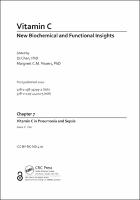Chapter 7 Vitamin C in Pneumonia and Sepsis
Proposal review
| dc.contributor.author | Carr, Anitra C. | |
| dc.date.accessioned | 2020-07-27T09:55:35Z | |
| dc.date.available | 2020-07-27T09:55:35Z | |
| dc.date.issued | 2020 | |
| dc.identifier.isbn | 9780429442025 | en_US |
| dc.identifier.uri | https://library.oapen.org/handle/20.500.12657/40107 | |
| dc.description.abstract | In humans, ascorbic acid is an essential vitamin, anti-oxidant and co-factor of a variety of metal ion-dependent enzymatic reactions. In this review, the transport of L-ascorbic acid is described from food to target cells. Transport of ascorbic acid across the plasma membrane is facilitated by members of the SLC23 family, SLC23A1/SVCT1 and SLC23A2/SVCT2. We present in silico models of these transporters that provide new insights into the structure of the SLC23 family. While SVCT1 is mainly responsible for uptake of ascorbic acid from the intestine into the blood and for reabsorption in the kidney, the more broadly expressed transporter SVCT2 delivers ascorbic acid into tissues that are in high demand of the vitamin. The oxidized form of ascorbic acid, dehydroascorbic acid (DHA), is a substrate of the GLUT transporters belonging to the SLC2 family. They play important roles in ascorbic acid recycling, such as in the brain and in erythrocytes. Ascorbic acid serves as an essential co-factor of metal ion-dependent enzymes, keeping their metal ions in the reduced state. In addition, it serves as an effective antioxidant in cells with high metabolic activity such as neurons. Thus, it is not too surprising that changes in expression and function of the SVCTs have nutritional and pathological consequences such as during ageing, malnutrition and chronic alcohol abuse or in cancer, neurodegenerative diseases and chronic inflammation diseases. In the future, SVCT1 and SVCT2 may furthermore prove useful as drug delivery systems, to enhance transport of novel pharmaceutical agents more efficiently across the intestinal epithelium and the blood-cerebrospinal fluid barrier. | en_US |
| dc.language | English | en_US |
| dc.subject.classification | thema EDItEUR::M Medicine and Nursing::MK Medical specialties, branches of medicine::MKG Pharmacology | en_US |
| dc.subject.classification | thema EDItEUR::P Mathematics and Science::PS Biology, life sciences::PSD Molecular biology | en_US |
| dc.subject.classification | thema EDItEUR::P Mathematics and Science::PS Biology, life sciences | en_US |
| dc.subject.other | antioxidants | en_US |
| dc.subject.other | ascorbic acid | en_US |
| dc.subject.other | infectious disease | en_US |
| dc.subject.other | intravenous ascorbate | en_US |
| dc.title | Chapter 7 Vitamin C in Pneumonia and Sepsis | en_US |
| dc.type | chapter | |
| oapen.relation.isPublishedBy | 7b3c7b10-5b1e-40b3-860e-c6dd5197f0bb | en_US |
| oapen.relation.isPartOfBook | b5f7db67-fe9c-4e84-b587-54aa1b8117c0 | en_US |
| oapen.imprint | CRC Press | en_US |
| oapen.pages | 26 | en_US |
| oapen.remark.public | 3-8-2020 - No DOI registered in CrossRef for ISBN 9781138337992 | |
| peerreview.anonymity | Single-anonymised | |
| peerreview.id | bc80075c-96cc-4740-a9f3-a234bc2598f1 | |
| peerreview.open.review | No | |
| peerreview.publish.responsibility | Publisher | |
| peerreview.review.stage | Pre-publication | |
| peerreview.review.type | Proposal | |
| peerreview.reviewer.type | Internal editor | |
| peerreview.reviewer.type | External peer reviewer | |
| peerreview.title | Proposal review | |
| oapen.review.comments | Taylor & Francis open access titles are reviewed as a minimum at proposal stage by at least two external peer reviewers and an internal editor (additional reviews may be sought and additional content reviewed as required). |

